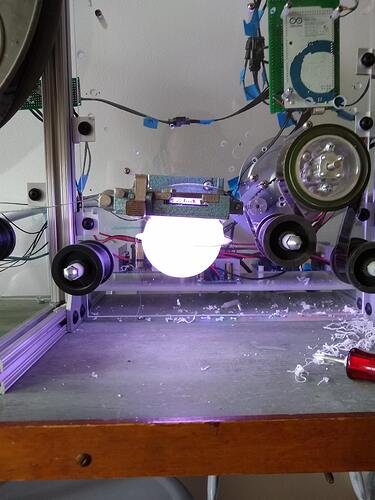I bought the Yuji Led VTC Series High CRI COB LED - 135L 3200K model, the published curves for it looked pretty close to the original illuminant that would have been in the projector that the films in my collection would have been viewed with - that and I’m pretty sure I like the response from the sensor in my build with a white balance around 3200K.
Like all machines that are involved in making, storing, manipulating and viewing pictures, the ones we’re building can be thought of like a system or an equation - each part/variable/factor (or illuminant, lens, medium or sensor) changes what comes out on the other side of the equals sign. To keep things as faithful or neutral as possible, I’m trying to pick imaging parts that are compatible, so as to reduce conflict or disagreement in components that may manifest as image artifacts. The light is just as critical a component as the lens, camera, etc.
When all this film was designed, the lighting was assumed to be incandescent (or discharge even) from the use on set to the lab to the projector. This the lighting was pretty much all homogenous. Now, since we’re working with aged material in certain cases, we have to be much more careful - those old hot lights can damage or increase the rate of damage to the film. However, the sacrifice made is that in figuring out how to eliminate the heat issue, we’re using lights that don’t produce light across the spectrum in the same way as the old ones.
LED’s typically are either on or off - they do not dim quite like older incandescent lights, but like older incandescents, their quality of light changes as they are dimmed. Thus there is an “optimal” condition in which to operate them to get the desired quality of light. If dimming is required (say you want to adjust relative brightness of a Red, Green and Blue LED separately), the most common way to go about doing that is with PWM. PWM is less desirable in our application because of the possibility of interference with the shutter on the camera - you may see banding or flickering due to the timing of the PWM and the timing of the shutter. That’s not to say it can’t be done - it just requires a great deal of effort to implement correctly.
Ideally (aside from dimming the light source) you’ll want to consider how well the light matches the film and how well it matches your sensor. Some films prints were designed to be viewed/projected with light of a particular color temperature and color sensors are designed to have a color response that is best at a particular color temperature. N.B. - I’m using color temperature as an umbrella term for a lot of concepts about how the energy of the light is distributed throughout the spectrum, but 6500K or “daylight” etc. are familiar terms that are understandable in a broad context.
For my build in particular, I picked a light source that at full brightness wouldn’t meet a damage threshold for my film during a likely exposure time in the gate and then decided to set my exposure with the shutter and aperture on my lens. Since I had a light that matched the film and sensor well, very minor white balance adjustment was able to be done “on-chip” in the camera. (There’s a wonderful set of papers that I don’t have the link to right now on how color records fade in many film stocks based on temperature, humidity and exposure to light.)

